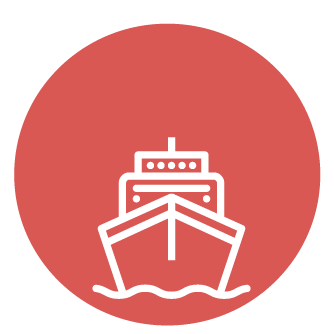*For more detailed data, consult the Eurostat Database on Migration and Asylum.
**This does not include those born in another Member State.
Foreign-born residents per country
Source: Eurostat; “other” includes permits issued for the reason of residence only, permits issued to victims of trafficking of human beings and unaccompanied minors, as well as permits issued for all other reasons for which residence permits may be issued and which are not covered by the other categories
Employment of immigrants
In 2022, 9.93 million non-EU citizens were employed in the EU labour market, out of 193.5 million persons aged from 20 to 64, corresponding to 5.1% of the total.
Source: Eurostat
The employment rate in the EU in the working-age population is higher for EU citizens (77.1%), than for non-EU citizens (61.9%) in 2022.
Over-represented sectors
In 2022, non-EU citizens were over-represented in some specific economic sectors such as:
| Sector | Employment of non-EU citizens | Employment of EU citizens |
|---|---|---|
| Accommodation and food service activities | 11.3% | 4.2% |
| Administrative and support service activities | 7.6% | 3.9% |
| Domestic work | 5.9% | 0.7% |
| Construction | 9.1% | 6.6% |
Over-representation by occupation
In terms of occupations, non-EU citizens were over-represented among:
| Occupational group | Employment of non-EU citizens | Employment of EU citizens |
|---|---|---|
| Cleaners and helpers | 11.4% | 2.9% |
| Personal services workers | 7.3% | 4.1% |
| Personal care workers | 5.5% | 3.0% |
| Construction workers, excluding electricians | 6.1% | 3.7% |
| Workers in mining, construction, manufacturing and transport | 6.0% | 2.5% |
| Food preparation assistants | 2.6% | 0.6% |
| Agricultural, forestry and fishery workers | 2.4% | 0.7% |
Under-represented sectors
Non-EU citizens were under-represented in other economic sectors, including:
| Sector | Employment of non-EU citizens | Employment of EU citizens |
|---|---|---|
| Public administration and defence, compulsory social security | 1.1% | 7.4% |
| Education | 3.9% | 7.6% |
| Human health and social work activities | 8.5% | 11.2% |
| Professional, scientific and technical activities | 3.8% | 6.0% |
Under-representation by occupation
On the other hand, non-EU citizens were under-represented among:
| Occupational group | Employment of non-EU citizens | Employment of EU citizens |
|---|---|---|
| Teaching professionals | 2.4% | 5.5% |
| Business and administration associate professionals | 2.6% | 6.8% |
| Clerical and administrative workers | 1.5% | 4.4% |
| Science and engineering associate professionals | 1.7% | 3.5% |
| Business and administration professionals | 2.3% | 4.5% |
| Health professionals | 1.5% | 3.1% |
Source: Eurostat
Refugees in Europe
Refugees from Ukraine
Since Russia’s military aggression against Ukraine in February 2022, Europe has received the largest number of people fleeing war since World War II. For up-to-date details on the efforts to welcome people fleeing the war in Ukraine and to provide temporary protection, see the dedicated page Migration management: Welcoming refugees from Ukraine.
Overall situation
Based on data from UNHCR, all around the world there were:
- 36.4 million refugees at mid-2023 and
- 62.5 million internally displaced persons (due to conflict and violence) at the end of 2022.
The share of refugees in the EU was 1.5% compared to its total population.
Number of refugees compared to total population
Several countries around the world host a large refugee population:
Note: data for 2022
While irregular migration is often in the spotlight, the reality is that irregular entries account for a small fraction of migration in the EU.
In 2022, over 3.4 million first residence permits were issued in the EU, compared to 2.9 million in 2021, exceeding numbers seen before the start of the COVID-19 pandemic (3.0 million in 2019). The number of first permits issued by Germany (+190%) and Ireland (+146%) more than doubled when compared to 2021. In 2022, there was a particularly large increase of asylum-related (+60%) permits but the number of permits issued for education (+29%), family (+29%) and other reasons (+47%) also increased year-on-year. On the other hand, the number of permits issued for work-related reasons decreased compared to 2021 (-6%). In 2022, first permits were issued for the following reasons:
Source: Eurostat; “other” includes permits issued for the reason of residence only, permits issued to victims of trafficking of human beings and unaccompanied minors, as well as permits issued for all other reasons for which residence permits may be issued and which are not covered by the other categories
Top 10 nationalities of first residence permits issued in EU Member States in 2022
Source: Eurostat
Source: Eurostat
Top 15 nationalities of first time asylum applicants (2023)
Source: Eurostat
In 2023, asylum seekers came from close to 150 extra-EU27 countries.
1,129,800 applications, including 1,049,000 first time applications, were lodged in the EU in 2023, an increase of 18% in comparison to 2022, and of 62% compared to 2019, before COVID.
A significant share of applicants come from visa-free countries (21% of asylum applicants in 2022, down from 22% in 2021, with a high number of applicants from Latin America) who enter the EU legally, mostly from:
- Venezuela (6.0% of all applications)
- Colombia (5.6%)
- Georgia (2.2%)
- Peru (2.1%)
- Ukraine (1.2%)

- Germany (329,000)
- Spain (160,500)
- France (145,100)
- Italy (130,600)
- Greece (57,900)

- Cyprus (1,300 per 100,000 inhabitants)
- Austria (650)
- Greece (600)
Source: Eurostat
In 2022, 271,500 people seeking asylum were under 18 years old – at least around one out of ten (31,0001) were unaccompanied minors. Most unaccompanied minors came from Afghanistan, Syria and Somalia.
Recognition of refugees
In 2023, EU countries issued 673,000 first instance asylum decisions. 53% of these decisions were positive:
- 152,000 persons received refugee status,
- 129,700 were granted subsidiary protection status,
- 75,400 received humanitarian status.
In 2023, at least a further 43,700 final decisions2 were issued following an appeal, including:
- 5,800 decisions granting refugee status,
- 1,700 granting subsidiary protection status,
- 10,400 granting humanitarian status.
Overall, EU countries granted protection to at least 375,100 people in 2023.
Effectiveness of the asylum system
- Fluctuating backlog
At the end of 2023, 883,000 asylum applications were pending - 39% more than the previous year, and double that of the period between 2017-2021. - Varying processing times across Member States
The ratio of pending cases and applications varies widely across Member States, reflecting the differences in processing time. According to the EU Agency for Asylum (EUAA) data, at the end of 2023, 49% of the cases pending at first instance had been pending for more than six months.
1Missing data for CZ, EL, ES, HR, CY, LT, NL
2Missing data for CZ, DE, EL, ES, FR, HR, CY, LT, NL
Number of pending applications compared to total number of applications in a given month
Source: Eurostat
- Varying recognition rates across EU countries
The EU’s asylum system is undermined due to significant differences in recognition rates across EU countries. For example, in 2023 the recognition rate of Afghan citizens at first instance (not including humanitarian status) ranged from 13% in Bulgaria to 99% in Ireland (from those Member States that issued at least 100 first instance decisions to Afghan citizens). - Dublin rules in practice
In 2022, Member States reported 174,500 outgoing requests under the Dublin rules sent to other Member States and other countries participating in the Dublin system to take responsibility for examining an application for international protection. Out of 158,200 decisions on such requests, 97,700 (62%) were accepted and 13,300 outgoing transfers were executed, corresponding to 14% of accepted requests.
Resettlement
In 2022, around 17,300 people in need of international protection were resettled from non-EU countries to EU Member States, 6% less than in 2021 but 97% more than in 2020.
Syrian nationals accounted for 63% of the people resettled.
Under joint EU resettlement schemes, more than 117,000 persons found protection in the EU since 2015. In addition, since 2021, more than 46,000 persons, mostly Afghans at risk, arrived to the EU via humanitarian admission. Member States receive support from the EU budget for resettlement and humanitarian admission.
Source: Frontex
2023:


Geographical distribution
2022
- Increase in crossings on the Central Mediterranean (+56%, 105,600), the Eastern Mediterranean(+113%, 43,900) and the Western Balkan routes (+134%, 144,100) compared to 2021.
- Decrease in crossings on the Western Mediterranean (including the Atlantic route from Western Africa to the Canary Islands) (-25%, 30,600) and the Eastern borders routes (-22%, 6,300) compared to 2021.
- 18% increase of deaths at sea: 2,411 persons were reported dead or missing in 2022 on the three Mediterranean routes, compared to 2,047 in 2021.
2023
- In 2023 there was an increase in crossings on the Central Mediterranean route (+54%, 162,700), the Atlantic and Western Mediterranean routes (+157%, 39,700 and +12%, 16,900, respectively) and the Eastern Mediterranean route (+57%, 60,800) compared to 2022.
- At the same time, there was a decrease in crossings on the Western Balkan route (-31%, 99,000) and the Eastern borders route (-10%, 5,700) compared to 2022.
- 29% increase of deaths at sea: 3,105 persons were reported dead or missing in 2023 on the three Mediterranean routes, compared to 2,411 in 2022.
The main countries of nationality of those ordered to leave the EU in 2023 were:
- Morocco (8.1%)
- Algeria (7.5%)
- Afghanistan (5.5%)
- Syria (5.0%)
- Türkiye (4.8%)
Effectiveness of the return system
In 2023, 83,400 non-EU citizens were returned to a non-EU country. This corresponds to 19% of all return decisions issued during the year, increasing from 17% in 2022.
Among the main countries of origin of those returned from the EU in 2023 were:
- Georgia (12.0%)
- Albania (9.3%)
- Türkiye (6.6%)
- Moldova (4.3%)
- Serbia (3.9%)
Among the nationalities with at least 5,000 return orders, the return rate was particularly low for those coming from:
- Syria (3%)
- Democratic Republic of the Congo (3%)
- Afghanistan (4%)
- Guinea (5%)
- Morocco (8%)
In 2023, the share of voluntary and forced returns was 46-54%. 75% of the returns were assisted returns - the persons returned received logistical, financial and/ or other material assistance.
Short stay visas
In 2022, nearly 1,700 Member States' consulates received 7.6 million short stay visa applications lodged by non-EU citizens, up from 2.9 million in 2021 but 55% less than in 2019.
In total, 5.9 million short stay visas were issued and 1.3 million were refused, amounting to an EU-wide refusal rate of 17.9% (up from 13.4% in 2021).
Most applications were lodged in:
- Türkiye (778,400)
- Russia (687,200)
- India (671,900)
- Morocco (423,200)
- Algeria (392,100)
Most visa applications were processed by:
- France (1,918,500)
- Spain (1,197,500)
- Germany (1,043,300)
- Italy (727,500)
- Greece (459,100)
58% of all visas were issued for multiple entries. Short stay visas cover travel throughout the 26 Schengen countries for up to 90 days in any 180-day period.
The Atlas on Migration
The Atlas on Migration of the European Commission’s Knowledge Centre on Migration and Demography is an interactive resource of harmonised, up-to-date and validated data on the status of migration and demography in 27 EU Member States and 171 non-EU countries and territories.
European statistics on migration and asylum
Up-to-date European statistics on:
Related information is also available on Eurostat's website.
Eurostat collects data from the National Statistics Authorities of the EU Member States and EFTA countries, based on statistical regulations adopted by the European Parliament and the Council. Data and related metadata are quality assured in line with the European Statistics Code of Practice, and updated at regular intervals depending on the data collection. Statistical findings are published in Statistics Explained articles and other publications.
Disclaimer: The above data is based on latest available information, updated on a quarterly basis, last update: April 2024.




